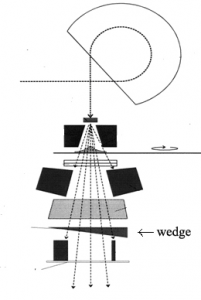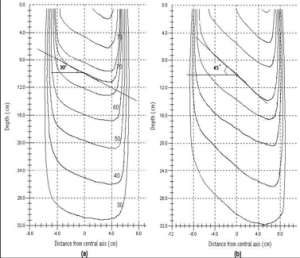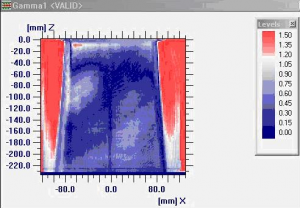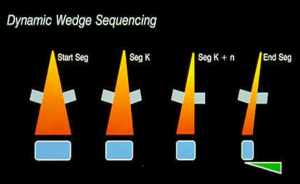Application of enhanced dynamic wedges in radiotherapy
29. Jún, 2009, Autor článku: Bajusová Alica, Informačné technológie, Medicína, Študentské práce
Ročník 2, číslo 6  Pridať príspevok
Pridať príspevok
 The paper deals with a method of radiotherapy that uses enhanced dynamic wedges (EDW) to modulate the intensity of radiation. Physical principle and the main advantages and the disadvantages of the EDW over the conventional physical wedges are described. The main purpose of this work is to describe a process of dosimetry verification of the application of the EDW that was applied on The Saint Elizabeth Cancer Institute in Bratislava and to detail the experiment of the verification of an isodose distribution within this implementation of the EDW.
The paper deals with a method of radiotherapy that uses enhanced dynamic wedges (EDW) to modulate the intensity of radiation. Physical principle and the main advantages and the disadvantages of the EDW over the conventional physical wedges are described. The main purpose of this work is to describe a process of dosimetry verification of the application of the EDW that was applied on The Saint Elizabeth Cancer Institute in Bratislava and to detail the experiment of the verification of an isodose distribution within this implementation of the EDW.
Radiotherapy is a therapeutic method that uses effect of ionizing radiation on malignant cells. It is an irreplaceable part of the cancer treatment. The aim of radiotherapy is to deliver the required high dose to the target volume whilst at the same time minimizing the dose to healthy tissue and avoiding any sensitive organs nearby (Parker and Patrocinio, 2005).
For this purpose, several techniques of irradiation are used in a clinical praxis of radiotherapy. They use different tools and methods to shape the irradiation field and to modulate the intensity of radiation.
This paper deals with a technique that uses enhanced dynamic wedges (EDW). Main purpose of this work is to compare the differences between the physical wedges and the EDW and to present a process of dosimetry verification of the application of the EDW on The Saint Elizabeth Cancer Institute in Bratislava.
Preliminaries and problem formulation
Physical wedges are used to modulate the intensity of radiation. Principally, they represent absorbent blocks made from metallic material and thay are placed into the path of X-ray beam at the output of an accelerator (Fig.1). They modify a dose distribution because of their shape (thin at one side and thick at the other side), so a dose gradient across the entire field is formed.

Fig. 1 Placing of a physical wedge
Wedge angle describes how big the gradient is. Several definitions of this term exist. According to ICRU (International Commission on Radiation Units and Measurements) the wedge angle is defined as the angle through which an isodose is titled at the central axis of the beam at a specified depth (usually 10 cm) (Cherry and Duxbury, 1998) (Fig 2). Physical wedges are made to provide four specific wedge angles: 15º, 30º, 45º a 60º.

Fig. 2 Isodose distribution using a) EDW 30º, b) EDW 45º
Enhanced dynamic wedges substitute the physical wedges. This technique achieves wedge-shaped dose distributions by computer-controlled movement of one of the collimator jaws (Fig. 3) under simultaneous adjustment of dose rate and speed of the moving jaw during the irradiation (Salk and Röttinger, 2003).
Different accelerators enable a different choice of the wedge angles for EDW. Varian provides 7 different angles: 10º, 15º, 20º, 25º, 30º, 45º and 60º. A continuous number of wedge angles are possible, specified from 15º to 60º, for the accelerators made by Siemens or Elekta (Gibbons, 2002).
Dynamic wedges have several advantages over the conventional physical ones: they eliminate the physical wedges; they can generate any arbitrary wedge angle; they reduce a treatment time; they reduce a dose that is outside the treatment plan and they provide better dose distributions of a straight isodose line without beam hardening. The main disadvantage of the EDW is a necessity of a systematic control and a verification of reliability and stability of the EDW.
This paper deals with a dosimetry verification of the implementation of the EDW at the Saint Elizabeth Cancer Institute in Bratislava. Physical wedges were used at this workstation recently, although the linear accelerators that were employed there for radiotherapy were offering the possibility of the application of the EDW. Because every implementation of a new method or a new device at the workstation desires a commissioning of the verification tests, it was necessary to verify, measure and calculate the following characteristics in order to use all mentioned advantages of the EDW:
- stability of the EDW
- calcul of the EDW factors for the different field sizes and the different wedge angles
- isodose distribution for the different field sizes and the different wedge angles
- profiles of the individual wedges
Consequently, the measured and the calculated dose values acquired from the planning systems were compared and the relative deviations were calculated. The next paragraph describes the experiment of the verification of an isodose distribution within this implementation of the EDW.
Experiment
Our experiment was realized at a linear accelerator CLINAC 600C/D that generates 6 MeV beams of braking radiation. A film dosimetry was used for measuring the isodose distribution that was than compared with the calculated isodose charts obtained from the planning system Oncentra MasterPlan (OMP). The software Omni Pro I’mRT (Scanditronix Wellhöfer) has served for comparing the calculated values acquired from OMP and the values obtained from film dosimetry by scanning the individual films.
First of all, a film calibration was done using the Kodak EDR2 films. Subsequently, the film was located vertically (in the direction of x and z-axes) into a black phantom made from a plastic material. The reference depth was chosen at 5 cm, SSD (source-to-surface distance) was 100 cm and two kinds of measurements denoted as A and B, were realized. Their parameters are listed in Tab. 1.
| Measumerent | EDW (Y1-IN) | Field size [cm×cm] |
|---|---|---|
| A | 10º ,15º, 30º, 45º, 60º | 15×15 (symmetric field) |
| B | 0º, 15º, 60º | 12×15 (asymmetric field) |
Tab.1 Parameters of the measurements
After irradiation, the films were developed in a darkroom. They were scanned with a scanner of high resolution and transferred into the Omni Pro I’mRT software. Some marks were made on the films before irradiation. They help with the adjustment of the scanned image obtained from a film to be in the same position as it was placed in the phantom. A plan that corresponds with that according to which the film was irradiated is chosen from the calculated values in OMP. Both systems are than standardized in the same point (intersection of the flowlines corresponding to the marked points on the films). The Omni Pro I’mRT software is able to superimpose both images for comparison of the dose distributions.
Main results
Figure 4 and 5 represent the outputs from the comparing software. By the help of figure 4 we can optically evaluate the correlation of dose distributions between measured (continuous line) and calculated (broken line) values.

Fig. 4 Comparison of the dose distribution. Field size: 15×15cm2; EDW 45
The result of the comparison is a display of both images using the gamma method. It defines a percentage difference between the measured and the calculated dose at certain distance. For example, for gamma factor 1,5 we can say that 100 % corresponds to 1,5 % of the difference between the measured and the calculated dose within a distance of 1,5 mm. The obtained image is colour scaled. In Fig. 5, the dark surfaces represent an area where the difference between the doses is lower than 1,5 % , the light areas exhibit the dose differences equal or higher than 1,5 %.

Fig. 5 Comparison of the dose distribution by the gamma method. Field size: 15×15cm2; EDW 45
From all obtained gamma indexes for different wedge angles and different field sizes we can say, that the differences between the measured and the calculated distributions of isodoses have not exceeded 1,5 % within the distance of 1,5 mm.
Conclusion
Our results have confirmed the conformity of the treatment at the Saint Elizabeth Cancer Institute when EDW are used. In this paper, we describe in detail only one step of the verification. Within the process of implementation of EDW, every workstation has to verify also the stability of EDW, the EDW factors and compare a correlation between the measured and the calculated profiles of individual dynamic wedges. This is a subject of the ongoing works.
References
- P. Cherry, A. Duxbury (1998). Practical radiotherapy physics and equipment, 139. Cambridge University Press
- J. P. Gibbons (2002). Field compensation; Dosimetric aspects of dynamic delivery with independent colllimators and MLC. Palmetto Richland Memorial Hospital. Columbia, South Carolina www.aapm.org/meetings/02AM/pdf/8282-60649.pdf
- W. Parker, H. Patrocinio (2005). Clinical treatment planning in external photon beam radiotherapy. In: Radiation Oncology Physics: a handbook for teachers and students (E. B. Podgorsak. (Ed)), 219. International Atomic Energy Agency, Vienna
- J.E. Salk, E.M. Röttinger (2003). Calculation of effective Enhanced Dynamic Wedge Factors from Segmented Treatment Tables for symmetric and asymmetric photon beams. Germany
Co-author of this paper is G. Králik and M. Miglierini.



04. Apríl, 2017 o 5:58
Have you ever thought about adding a little bit more than just your articles?
I mean, what you say is fundamental and all. Nevertheless imagine
if you added some great visuals or video clips to give your posts more, “pop”!
Your content is excellent but with pics and clips, this blog could definitely be one of the greatest in its niche.
Wonderful blog!